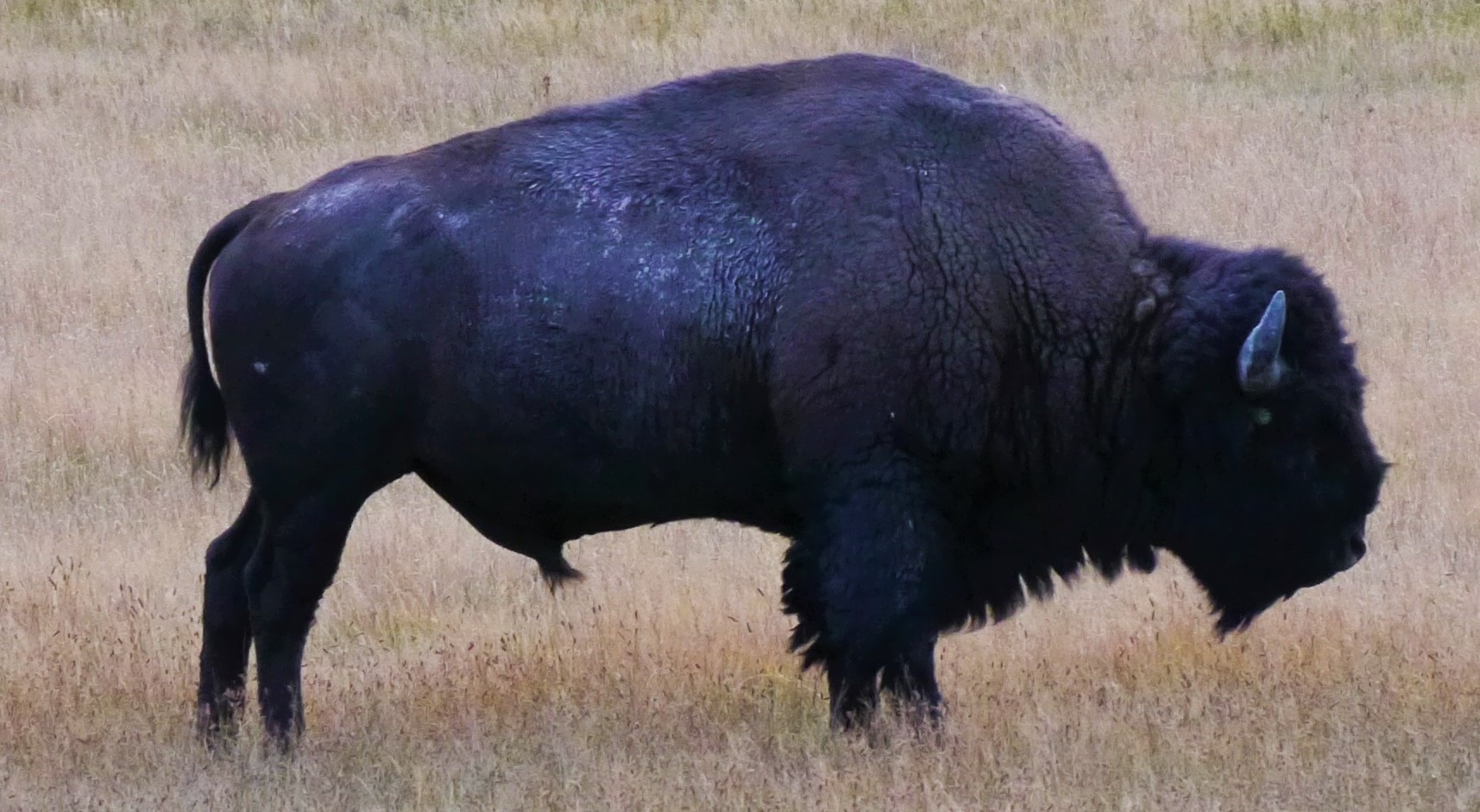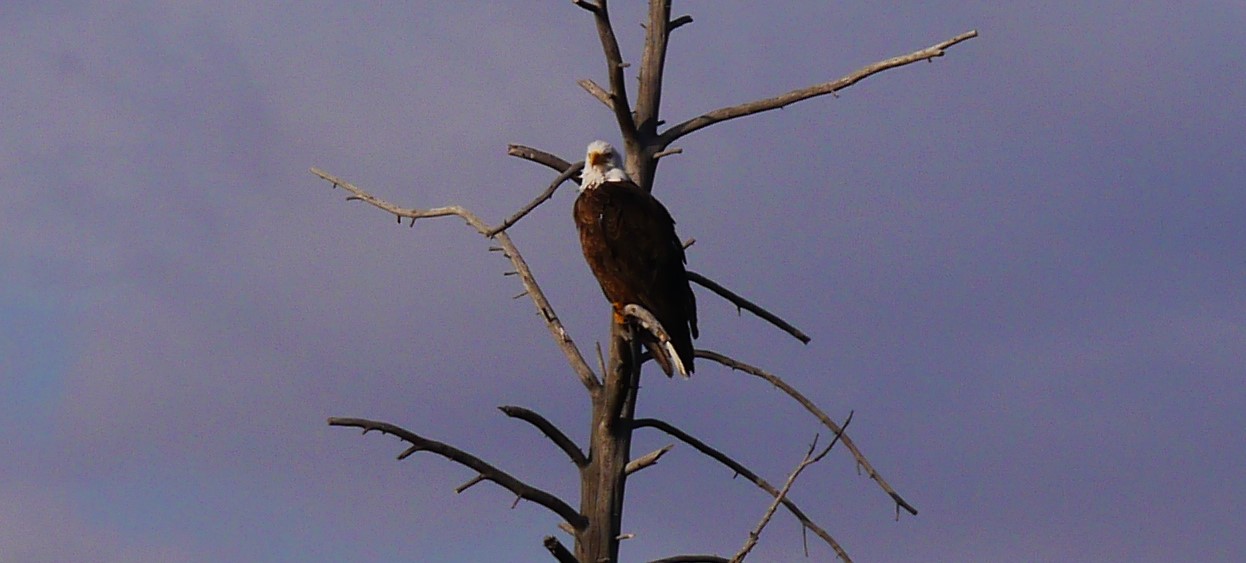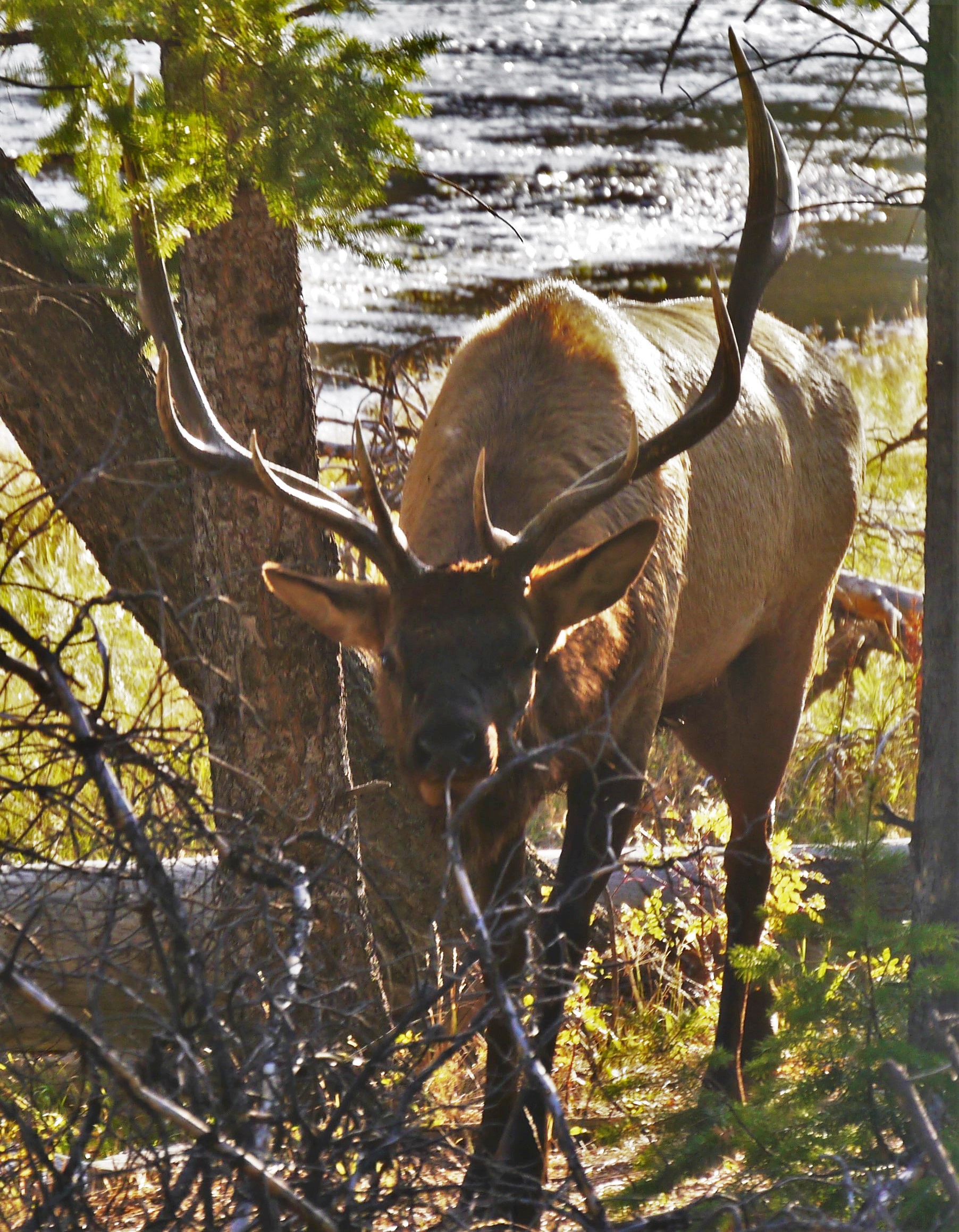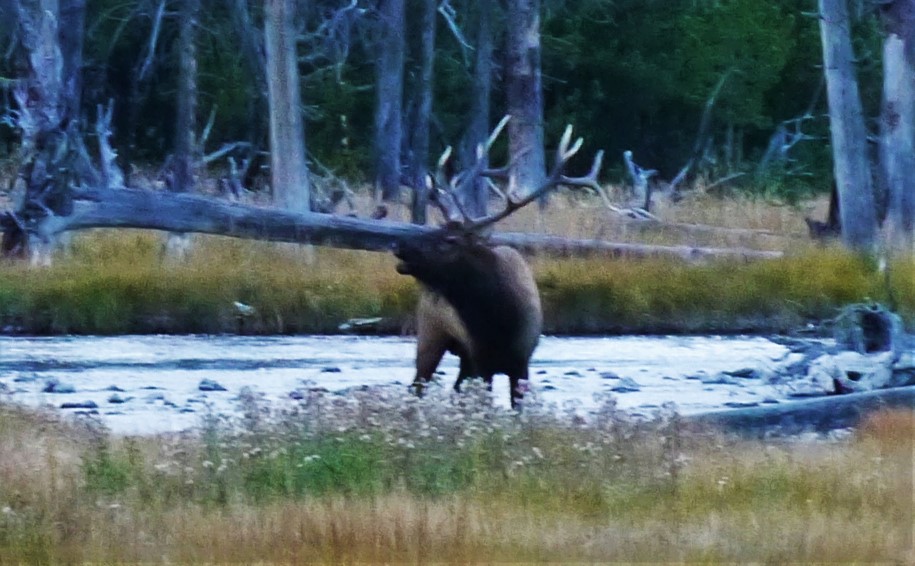
Picture: Noble Bison–Two thousand pound survivor from the last ice age
After securing a campsite at Baker’s Hole just outside the West Entrance to Yellowstone it is a day of chores and getting settled in. We then take in the excellent museum and park visitor center in West Yellowstone. It is now into evening but we are anxious to at least drive a little into the park in our rented jeep. So off we go, gradually realizing this is an excellent time of day to see the animals as the coolness of evening brings them out; we are driving next to the Madison River where the larger animals like to come and drink and eat the sweet grass.
The first turnoff shows some promise of a view of the river and had a boardwalk built for that purpose. Our attention is drawn to an enormous bald eagle on a snag across the flowing river. We walk down to and along the river for further sights. When we return to a close view of the eagle I walk a little closer to the river for a picture, just then he turns his head in my direction–beautiful shot. “Thank you Mr. Eagle for you darshan.”

Picture: Large eagle gives me his darshan
On we drive, with most of the traffic going out the park in the opposite direction–good for us. A car stopped on the road in front of us alerts us to a bull bison just to the side. These majestic creatures numbered in the millions, with one herd counting in at a million buffaloes that stretched sixty miles in length! They had been hunted to near extinction for a variety of reasons, one was the value of their pelts and leather, and the second came towards the end when it was seen as a way to resolve “the Indian problem,” forcing native tribes onto reservations by robbing them of their food, shelter and tools that the buffaloes provided. The number in the park was reduced to twenty five buffaloes, a few hundred in total were left when the army stepped in to preserve the few survivors.
These beasts are enormous, weighing in at a ton for males, half a ton for females. Strong and limber, jumping a six foot high obstacle from a standing position and running 35 miles per hour they are a fearsome product of nature. Buffaloes have the distinction of having survived from the last ice age and have outlasted many of the other animals of that time period. Today the herds number in the tens of thousands and a problem now takes place when they wander off the Park grounds and are the unwelcomed guests of ranchers and homeowners–imagine one or more of these two thousand pounders munching on your lawn or wandering in the playground of the local elementary school! Having the pleasure of the darshan of this noble wonder, we drive on.
A few cars from our direction stop and a corresponding traffic jam of a mile or more coming from the other way indicate a herd of elk just off the side of the road on the strip of land that spans a few hundred feet down to the river. A large bull elk and his harem are moving down the grassy slopes and through the pine trees on a leisurely graze. We stop to get out and see these wild ones closer up (but careful to be not too close). As we stand at a distance a female wapiti ( (a term for elk from the Shawnee, meaning white rump) comes near to me. Carla, who quickly retreats, says the cow is coming for my darshan. The head bull is not pleased with this proximity and also moves towards me through the trees to warn away any uninvited visitors–that being me! I gracefully make my way back, this being close quarters with large animals and surrounded by trees. The bull herds the cow back into his comfort zone. Just how big this bull is and how powerfully he moves is even more evident when he has me in his sights!

Picture: Bull Elk has me in his sights
We motor on and come to a wide open field at the confluence of the Madison and the Fire Hole Rivers (called a prayag in India–a holy site), where a buffalo (formal name is bison) is off in the field. Carla has been keen to see buffalo so we stop. There is also a herd of elk down by the river. We stalk the buffalo for a while then head down to the river toward the elk. There is a very large bull and many cows, with another younger bull also in attendance.
The sun sets on this charming scene and we sit on a bench watching the various actors in this scenario, including a few human varieties. With increasing regularity the large bull elk bugles his call, an unusual and very loud sound. Off in the distance we hear another bull elk also bugling–someone walking by suggests there may be another herd nearby.
As this scene continues to unfold a single bull elk appears off to our left and it becomes obvious he is the origin of the other bugle calls. Now this is getting quite interesting–both bulls are making alternating calls, it seems a challenger for one or all the females has found his way to the herd. By the size of his antlers he is large, but not quite as large as the current head of the herd, who weighs in at over a thousand pounds. Autumn is mating season when the males are in rut (rut is derived from Latin meaning roar, or the bugling sound they make).

Picture in low light: Large Bull Elk bugling in defense of his harem
There are two females who are outliers from the herd and they seem to be the object of this challenger. We move down to the riverside and watch in breathless anticipation as the two bulls grow closer, each making tremendous noise. The larger bull is slowly moving toward the challenger. We have little knowledge of their mating and challenging habits, so all of this is an extraordinary play unfolding before us. Clashing horns is not a usual part of the challenge, but a display of antlers, bugling, and posturing is effective in eventually making the challenger break off his pursuit of the one cow further up in the woods. However he makes his way across the river toward us in pursuit of the other cow.
Carla makes a wise retreat, and I have a few small trees next to me to use as defense if that should be necessary. The larger bull then comes across the creek as well and successfully defends his other cow, although she seems interested in the newcomer. Finally with bull calls, grunts (typical male) and movements toward her, finally the female seems to come out of her entrancement with the newcomer and runs back across the river downstream where the rest of the herd is grazing down the valley. All of this has been taking place for the past thirty or forty minutes and has kept us spellbound.
By now it is getting very dark and a forest ranger has arrived at the nearby Madison Creek Campground to give a talk and slideshow on the Bison. We decide to stay for that. After a fascinating presentation we make the forty minute drive in the dark back to our campsite. Although we had a late start to our safari for our first day in the park Ram has seen to it that is has been a thriller. It really is remarkable how much can be packed into a relatively short amount of time when God is the tour guide!